glitterata
Ideal_Rock
- Joined
- Apr 17, 2002
- Messages
- 4,807
Hello, jewelry friends.
A decade ago, I bought a mysterious $11 Victorian stickpin on eBay, which the generous and knowledgeable Rich Sherwood identified as (spoiler alert!) a nice chrysoberyl cat's eye. It was set in 18K gold, and I had a jeweler snip off the stem, bend it into a band, and attach it to the pin head, converting the pin into a ring. I love it and wear almost every day. Here's the thread about it:
Chrysoberyl cat's eye thread from 2009
Ten years went by. Continents drifted, civilizations rose and fell, new freckles and wrinkles appeared on my hands.
Then, a few weeks ago, I won an eBay auction for another Victorian stickpin. The seller, a UK jeweler, described it as a chrysoberyl cat's eye set in a 9ct gold head with a steel pin. The setting looks 19th century--I would guess around 1880s. I believe the seller that the head is 9ct (9K); not sure about the pin, which is silver-colored, doesn't attract a magnet, and shows signs of having once been gilded.
This cat's eye stone is very similar to my first pin/ring in color, a touch yellower. It's way, WAY bigger--10 x 14mm, with a high dome. The measurements are exact: it's not approximately 10 x 14, it's PRECISELY 10 x 14. It appears almost opaque to me. It has a straight, sharp eye in sunlight and spotlight, and a wide, fibrous white stripe in diffuse light. The inclusions that give it its eye are coarser than in my first chrysoberyl cat's eye. Unlike the first one, the new one doesn't do milk and honey. It has no surface scratches, despite being obviously very old (over a century) and despite lots of wear to the setting. And fascinatingly, under a blacklight the first chrysoberyl cat's eye has a definite red/pink fluorescence, while the new one has a mottled chartreuse-y yellow fluorescence that's just as strong. The fluorescence is not as pronounced as in my diamonds with strong blue fluorescence, but it's much stronger than the diamonds with faint blue fluorescence.
What do you think?
1. Is this also a chrysoberyl cat's eye? If not, what is it?
2. Should I make it into a ring, preserving the head and adding a band?
3. If I make it a ring, set it north-south or east-west? (I have shortish, widish fingers).
The new pin, front, back, and profile:
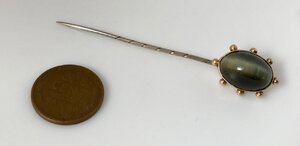
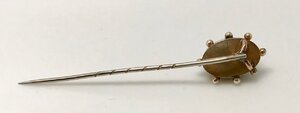
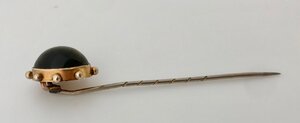
In direct sunlight, with my ring. See how the ring shows milk-and-honey, but the new pin doesn't?
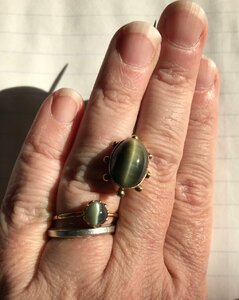
Facing front in sunlight:
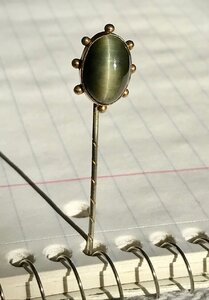
The best photo I managed to take that more or less shows the fluorescence. In real life that chrysoberyl cat's eye ring is redder and brighter. One of the melee diamonds in my diamond ring setting apparently has SB or VSB fluorescence.
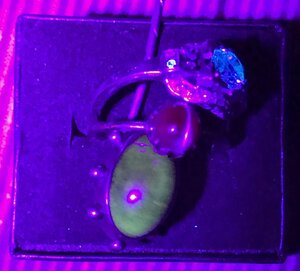
A few photos of the new pin's surface that I took with a microscope. These show the fibers touching the surface (those are not scratches):
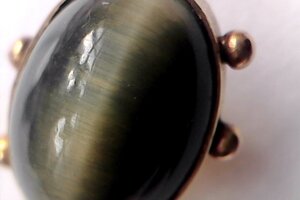
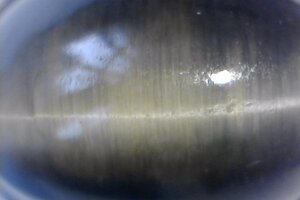
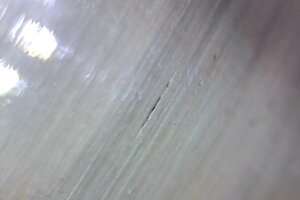
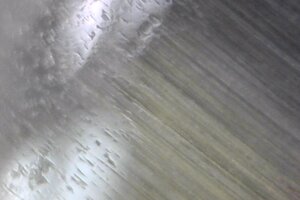
A decade ago, I bought a mysterious $11 Victorian stickpin on eBay, which the generous and knowledgeable Rich Sherwood identified as (spoiler alert!) a nice chrysoberyl cat's eye. It was set in 18K gold, and I had a jeweler snip off the stem, bend it into a band, and attach it to the pin head, converting the pin into a ring. I love it and wear almost every day. Here's the thread about it:
Chrysoberyl cat's eye thread from 2009
Ten years went by. Continents drifted, civilizations rose and fell, new freckles and wrinkles appeared on my hands.
Then, a few weeks ago, I won an eBay auction for another Victorian stickpin. The seller, a UK jeweler, described it as a chrysoberyl cat's eye set in a 9ct gold head with a steel pin. The setting looks 19th century--I would guess around 1880s. I believe the seller that the head is 9ct (9K); not sure about the pin, which is silver-colored, doesn't attract a magnet, and shows signs of having once been gilded.
This cat's eye stone is very similar to my first pin/ring in color, a touch yellower. It's way, WAY bigger--10 x 14mm, with a high dome. The measurements are exact: it's not approximately 10 x 14, it's PRECISELY 10 x 14. It appears almost opaque to me. It has a straight, sharp eye in sunlight and spotlight, and a wide, fibrous white stripe in diffuse light. The inclusions that give it its eye are coarser than in my first chrysoberyl cat's eye. Unlike the first one, the new one doesn't do milk and honey. It has no surface scratches, despite being obviously very old (over a century) and despite lots of wear to the setting. And fascinatingly, under a blacklight the first chrysoberyl cat's eye has a definite red/pink fluorescence, while the new one has a mottled chartreuse-y yellow fluorescence that's just as strong. The fluorescence is not as pronounced as in my diamonds with strong blue fluorescence, but it's much stronger than the diamonds with faint blue fluorescence.
What do you think?
1. Is this also a chrysoberyl cat's eye? If not, what is it?
2. Should I make it into a ring, preserving the head and adding a band?
3. If I make it a ring, set it north-south or east-west? (I have shortish, widish fingers).
The new pin, front, back, and profile:



In direct sunlight, with my ring. See how the ring shows milk-and-honey, but the new pin doesn't?

Facing front in sunlight:

The best photo I managed to take that more or less shows the fluorescence. In real life that chrysoberyl cat's eye ring is redder and brighter. One of the melee diamonds in my diamond ring setting apparently has SB or VSB fluorescence.

A few photos of the new pin's surface that I took with a microscope. These show the fibers touching the surface (those are not scratches):







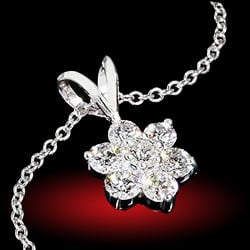
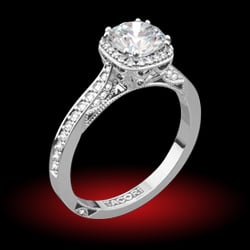
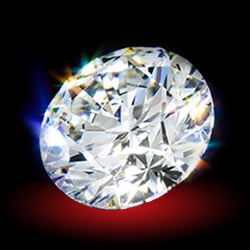



300x240.png)